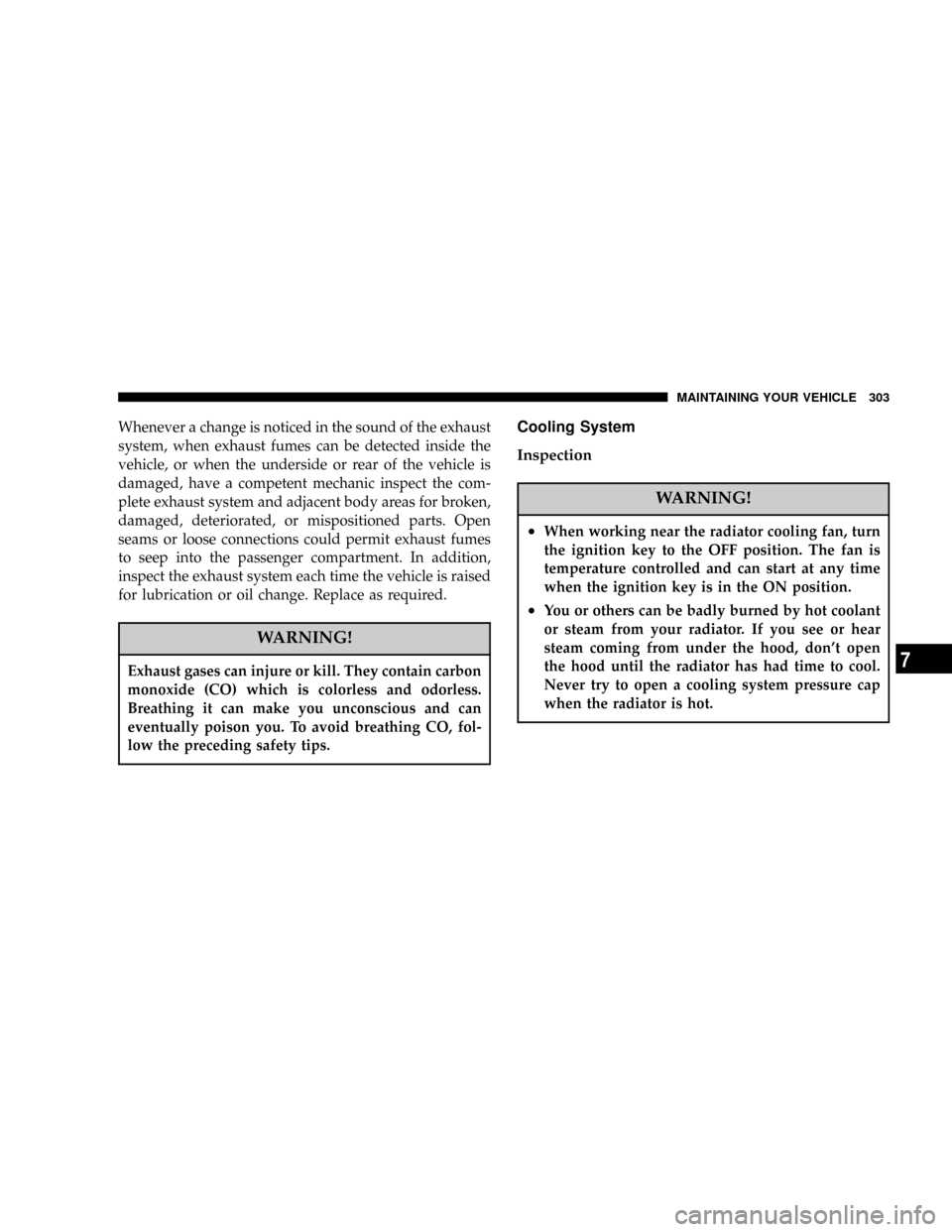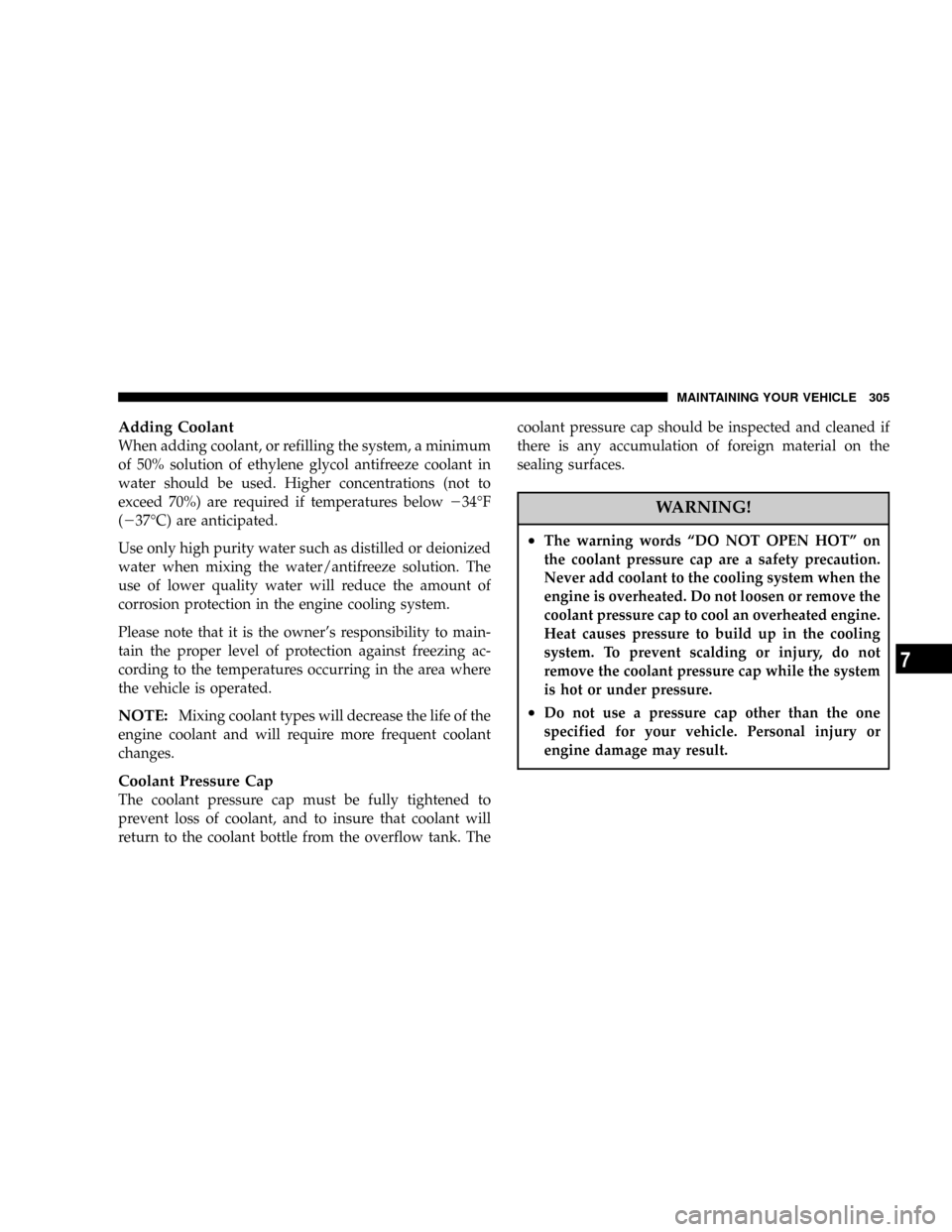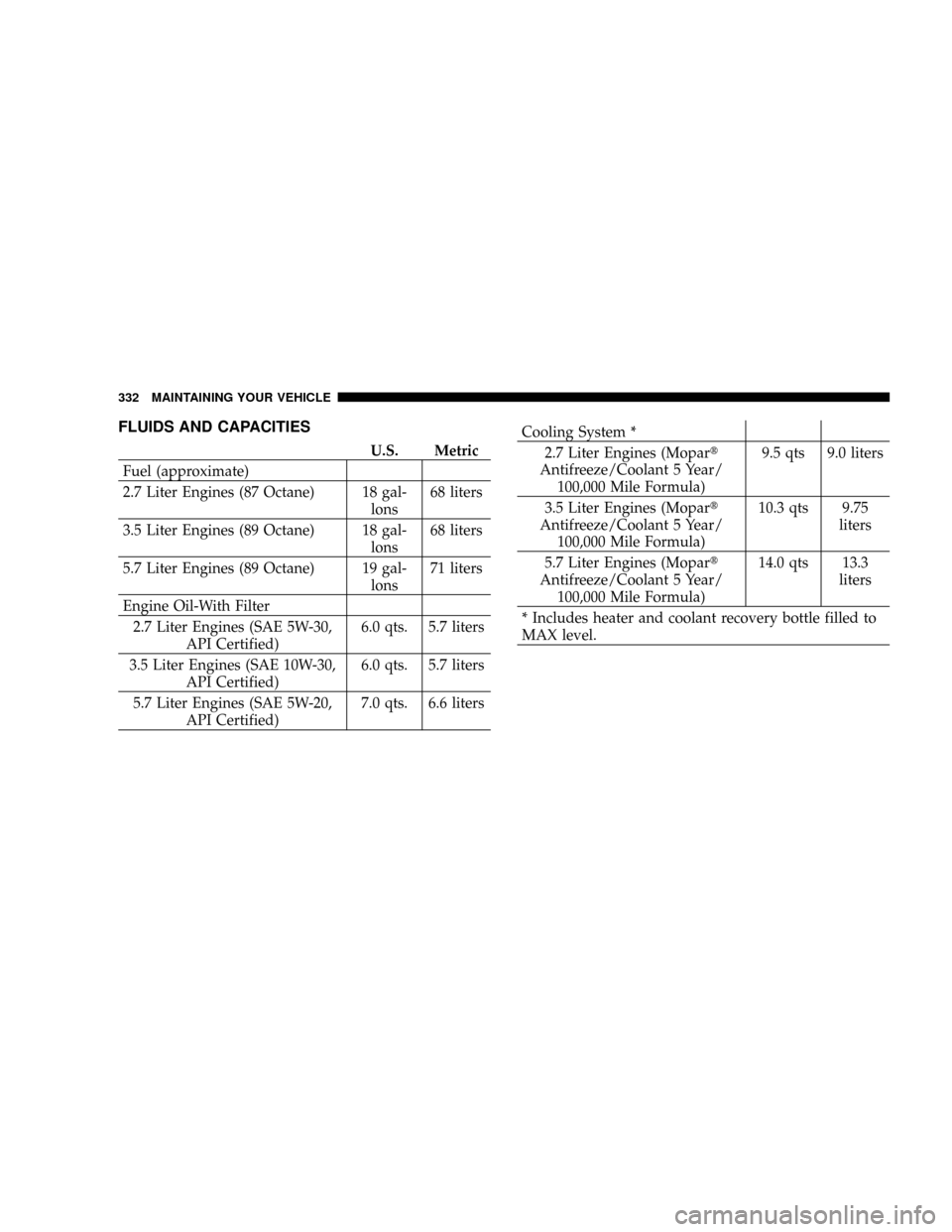2005 CHRYSLER 300 cooling
[x] Cancel search: coolingPage 303 of 374

Whenever a change is noticed in the sound of the exhaust
system, when exhaust fumes can be detected inside the
vehicle, or when the underside or rear of the vehicle is
damaged, have a competent mechanic inspect the com-
plete exhaust system and adjacent body areas for broken,
damaged, deteriorated, or mispositioned parts. Open
seams or loose connections could permit exhaust fumes
to seep into the passenger compartment. In addition,
inspect the exhaust system each time the vehicle is raised
for lubrication or oil change. Replace as required.
WARNING!
Exhaust gases can injure or kill. They contain carbon
monoxide (CO) which is colorless and odorless.
Breathing it can make you unconscious and can
eventually poison you. To avoid breathing CO, fol-
low the preceding safety tips.
Cooling System
Inspection
WARNING!
²When working near the radiator cooling fan, turn
the ignition key to the OFF position. The fan is
temperature controlled and can start at any time
when the ignition key is in the ON position.
²You or others can be badly burned by hot coolant
or steam from your radiator. If you see or hear
steam coming from under the hood, don't open
the hood until the radiator has had time to cool.
Never try to open a cooling system pressure cap
when the radiator is hot.
MAINTAINING YOUR VEHICLE 303
7
Page 304 of 374

Coolant Checks
Coolant protection checks should be made every 12
months (prior to the onset of freezing weather, where
applicable). If coolant is dirty or rusty in appearance, the
system should be drained, flushed and refilled with fresh
coolant. Check the front of the A/C condenser for any
accumulation of bugs, leaves, etc. If dirty, clean by gently
spraying water from a garden hose vertically down the
face of the condenser.
Check the cooling system hoses for brittle rubber, crack-
ing, tears, cuts and tightness of the connection at the
bottle and radiator. Inspect the entire system for leaks.
Cooling System Ð Drain, Flush and Refill
At the intervals shown in the appropriate maintenance
schedule, the system should be drained, flushed and
refilled.
If the solution is dirty or contains a considerable amount
of sediment, clean and flush with a reliable cooling
system cleaner. Follow with a thorough rinsing to remove
all deposits and chemicals. Properly dispose of old
antifreeze solution.
Selection Of Coolant
Use only the manufacturers recommended coolant, refer
to Recommended Fluids, Lubricants and Genuine Parts
for correct coolant type.
CAUTION!
²Mixing of coolants other than the specified HOAT
coolant may result in decreased corrosion protec-
tion and engine damage that may not be covered
under the new vehicle warranty. If a non-HOAT
coolant is introduced into the cooling system in an
emergency, it should be replaced with the specified
coolant as soon as possible.
²Do not use plain water alone or alcohol base
antifreeze products. Do not use additional rust
inhibitors or antirust products, as they may not be
compatible with the radiator coolant and may plug
the radiator.
²This vehicle has not been designed for use with
Propylene Glycol based coolants. Use of Propylene
Glycol based coolants is not recommended.
304 MAINTAINING YOUR VEHICLE
Page 305 of 374

Adding Coolant
When adding coolant, or refilling the system, a minimum
of 50% solution of ethylene glycol antifreeze coolant in
water should be used. Higher concentrations (not to
exceed 70%) are required if temperatures below234ÉF
(237ÉC) are anticipated.
Use only high purity water such as distilled or deionized
water when mixing the water/antifreeze solution. The
use of lower quality water will reduce the amount of
corrosion protection in the engine cooling system.
Please note that it is the owner's responsibility to main-
tain the proper level of protection against freezing ac-
cording to the temperatures occurring in the area where
the vehicle is operated.
NOTE:Mixing coolant types will decrease the life of the
engine coolant and will require more frequent coolant
changes.
Coolant Pressure Cap
The coolant pressure cap must be fully tightened to
prevent loss of coolant, and to insure that coolant will
return to the coolant bottle from the overflow tank. Thecoolant pressure cap should be inspected and cleaned if
there is any accumulation of foreign material on the
sealing surfaces.
WARNING!
²The warning words ªDO NOT OPEN HOTº on
the coolant pressure cap are a safety precaution.
Never add coolant to the cooling system when the
engine is overheated. Do not loosen or remove the
coolant pressure cap to cool an overheated engine.
Heat causes pressure to build up in the cooling
system. To prevent scalding or injury, do not
remove the coolant pressure cap while the system
is hot or under pressure.
²Do not use a pressure cap other than the one
specified for your vehicle. Personal injury or
engine damage may result.
MAINTAINING YOUR VEHICLE 305
7
Page 306 of 374

Disposal of Used Engine Coolant
Used ethylene glycol based engine coolant is a regulated
substance requiring proper disposal. Check with your
local authorities to determine the disposal rules for your
community. To prevent ingestion by animals or children
do not store ethylene glycol based engine coolant in open
containers or allow it to remain in puddles on the
ground. If ingested by a child, contact a physician
immediately. Clean up any ground spills immediately.
Coolant Level
The coolant bottle provides a quick visual method for
determining that the coolant level is adequate. With the
engine off and cold, the coolant level should be between
the ranges indicated on the bottle. Some darkening of the
coolant bottle will occur over time. This is normal.
When additional coolant is needed to maintain the
proper level, it should be added to the coolant bottle. Do
not overfill. See your authorized dealer to properly fill
the cooling system.
Points to Remember
NOTE:
When the vehicle is stopped after a few miles of
operation, you may observe vapor coming from the front
of the engine compartment. This is normally a result of
moisture from rain, snow, or high humidity accumulat-
ing on the radiator and being vaporized when the
thermostat opens, allowing hot coolant to enter the
radiator.
If an examination of your engine compartment shows no
evidence of radiator or hose leaks, the vehicle may be
safely driven. The vapor will soon dissipate.
²Do not overfill the coolant bottle.
²Check coolant freeze point in the system.
²If frequent coolant additions are required, the cooling
system should be pressure tested for leaks.
²Maintain coolant concentration at 50% ethylene glycol
antifreeze (minimum) in water for proper corrosion
protection of your engine which contains aluminum
components.
306 MAINTAINING YOUR VEHICLE
Page 307 of 374

²Make sure that the radiator and coolant bottle hoses
are not kinked or obstructed.
²Keep the front of the radiator and the front of the A/C
condenser clean.
²Do not change the thermostat for summer or winter
operation. If replacement is ever necessary, install
ONLY the correct type thermostat. Other designs may
result in unsatisfactory cooling performance.
²Increasing engine speed at idle does not reduce cool-
ant temperature! Put transmission in NEUTRAL and
let engine idle at normal engine idle speed.
Hoses And Vacuum/Vapor Harnesses
Inspect surfaces of hoses and nylon tubing for evidence
of heat and mechanical damage. Hard or soft spots,
brittle rubber, cracking, tears, cuts, abrasions, and exces-
sive swelling indicate deterioration of the rubber.Pay particular attention to those hoses nearest to high
heat sources such as the exhaust manifold. Inspect hose
routing to be sure hoses do not come in contact with any
heat source or moving component which may cause heat
damage or mechanical wear.
Insure nylon tubing in these areas has not melted or
collapsed.
Inspect all hose connections such as clamps and cou-
plings to make sure they are secure and no leaks are
present.
Components should be replaced immediately if there is
any evidence of wear or damage that could cause failure.Brakes
In order to assure brake system performance, all brake
system components should be inspected periodically.
Suggested service intervals can be found in the Mainte-
nance Schedules section of this manual.
MAINTAINING YOUR VEHICLE 307
7
Page 332 of 374

FLUIDS AND CAPACITIES
U.S. Metric
Fuel (approximate)
2.7 Liter Engines (87 Octane) 18 gal-
lons68 liters
3.5 Liter Engines (89 Octane) 18 gal-
lons68 liters
5.7 Liter Engines (89 Octane) 19 gal-
lons71 liters
Engine Oil-With Filter
2.7 Liter Engines (SAE 5W-30,
API Certified)6.0 qts. 5.7 liters
3.5 Liter Engines (SAE 10W-30,
API Certified)6.0 qts. 5.7 liters
5.7 Liter Engines (SAE 5W-20,
API Certified)7.0 qts. 6.6 liters
Cooling System *
2.7 Liter Engines (Mopart
Antifreeze/Coolant 5 Year/
100,000 Mile Formula)9.5 qts 9.0 liters
3.5 Liter Engines (Mopart
Antifreeze/Coolant 5 Year/
100,000 Mile Formula)10.3 qts 9.75
liters
5.7 Liter Engines (Mopart
Antifreeze/Coolant 5 Year/
100,000 Mile Formula)14.0 qts 13.3
liters
* Includes heater and coolant recovery bottle filled to
MAX level.
332 MAINTAINING YOUR VEHICLE
Page 364 of 374

Compass Variance...................... 151
Computer, Trip/Travel................... 149
Console.............................. 130
Console, Floor......................... 130
Console, Overhead...................... 118
Contract, Service....................... 354
Coolant Pressure Cap.................... 305
Cooling System........................ 303
Adding Coolant (Antifreeze)............. 305
Coolant Capacity..................... 332
Coolant Level........................ 306
Disposal of Used Coolant............... 306
Drain, Flush, and Refill................. 304
Inspection........................... 303
Points to Remember................... 306
Pressure Cap........................ 305
Radiator Cap........................ 305
Selection of Coolant.............304,332,333
Cruise Control......................... 115
Cup Holder........................129,315
Customer Assistance.................... 352
Data Recorder, Event..................... 48Dealer Service......................... 289
Defroster, Rear Window.................. 195
Defroster, Windshield...............59,196,201
Delay Wipers.......................... 108
Diagnostic System, Onboard............... 287
Dimmer Switch, Headlight................ 106
Disposal
Antifreeze........................... 306
Door Locks............................ 15
Door Locks, Automatic................... 17
Door Opener, Garage.................... 119
Drive Belts............................ 295
Drive Shaft Universal Joints............... 301
Driver's Seat Glide Feature................ 95
Driving
On Slippery Surfaces.................. 276
Electric Remote Mirrors................... 67
Electrical Power Outlets.................. 127
Electronic Speed Control................. 115
Electronic Stability Program............... 113
Electronic Vehicle Information Center........ 147
364 INDEX
Page 365 of 374

Emergency, In Case of
Overheating......................... 264
Emission Control System Maintenance....288,336
Engine............................285,286
Air Cleaner.......................... 296
Air Cleaner Filter..................... 295
Block Heater......................... 209
Break-In Recommendations............... 57
Checking Oil Level.................290,291
Compartment.....................285,286
Coolant............................ 333
Cooling............................ 303
Exhaust Gas Caution.................. 253
Fails to Start......................... 208
Fuel Requirements.................250,332
Oil ..........................290,332,333
Oil Change Interval................... 292
Oil Selection......................292,332
Oil Synthetic......................... 294
Overheating......................... 264
Temperature Gauge................... 143
Enhanced Accident Response Feature......... 43
Event Data Recorder..................... 48Exhaust Gas Caution...............58,253,303
Exhaust System........................ 302
Exterior Folding Mirrors.................. 66
Filters
Air Cleaner.......................... 295
Air Conditioning..................203,300
Engine Fuel......................... 296
Engine Oil.......................295,333
Engine Oil Disposal................... 294
Flashers
Hazard Warning...................... 264
Turn Signal.......................... 140
Flash-To-Pass.......................... 106
Flat Tire Changing...................... 265
Floor Console.......................... 130
Fluid Capacities........................ 332
Fluid Leaks............................ 59
Fluid Level Checks
Brake.............................. 334
Power Steering....................300,334
Fog Lights.........................105,140
Folding Rear Seat....................... 97
INDEX 365
10